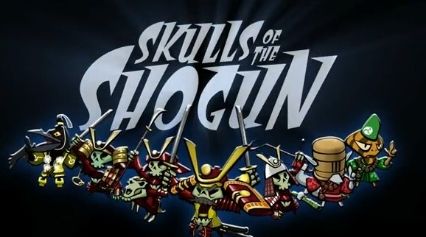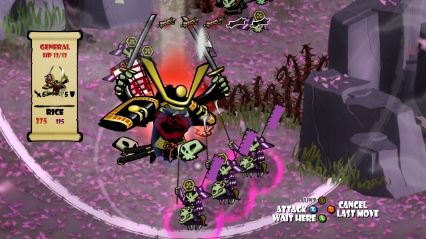
- Format: PC (version reviewed), XBLA, Windows Phone
- Unleashed: Out Now
- Publisher: Microsoft Studios
- Developer: 17-BIT
- Players: 1-4
- Site: http://skullsoftheshogun.com/
General Akamoto is furious; he’s arrived at the afterlife’s shores following a long life of blood and glory only to find his just reward locked behind an endless line of downtrodden warriors, each waiting their own turn for the promised paradise. Having no stomach for patience, he breaks every rule the underworld’s got in it and gathers an army to challenge this Shogun of the Dead, ready to cleave a reckless path through whatever might dare stand before him. Skulls of the Shogun’s simple tale is an apt allegory for the game’s own goals, as it strives to challenge a stagnant genre with a stubborn refusal to simply play by its rules.
Though a rebel in many respects, Skulls of the Shogun makes no bones about its roots in Advance Wars, a defining pillar of turn-based strategy as we know it. Buildings will be captured, resources gathered, and units deployed as armies are pitted against each other in a politely consecutive manner. Where it veers from tradition is in its efforts to break through rigidity and complexity in service of a more free-spirited pace. Movement is no long restrained to a grid, dozens of units are reduced to just seven, and resources are kept so scarce as to make any lasting stalemate an impossibility. A battle should rarely take even half an hour, and anyone intimidated by the genre should find the reliance on a simple trinity of infantry, cavalry and archers a welcome introduction. It’s a solid few rules to manage, and smashing down your enemies only to eat up their skulls, gaining both experience and health for your own troops, has a certain sadistic satisfaction to it.

Unlike katana, however, this loose simplicity is a double-edged sword. The game is rife with imprecision and a feeling of nonchalant hand-waving when it comes to the movement and range of units, with no effective way to estimate who can get where, or who can hit what. This is one of the key fundamentals of any turn-based strategy game, so being reduced to guessing half the time quickly lends itself to an air of ambivalence that encourages sloppy play. This would be easier to ignore if the game had more complexities to compensate, but the dearth of units and mechanics just makes movement and placement all the more noticeable.
We have another bone to pick with this same lack of depth; the best course of action is often easy to spot for anyone familiar to the concepts, making the process of overcoming the AI more an exercise in waiting than strategy. Just make enough archers and the AI’s simple-minded aggressiveness will soon fall victim to a volley of arrows. This makes the brief single-player campaign even briefer, which we managed to complete in under five hours. The Bone-A-Fide release for Steam also adds both a new unit and an extra episode to the campaign that lasts up to an hour or two, which is admittedly considerable, but that says something about the original campaign’s length. A simple yet effectively-implemented array of multiplayer options helps to pick up the AI’s slack and add some much-needed longevity, but it’s still victim to the game’s structural foibles.

Though some games with similarly unfulfilling mechanics can rest on an engaging world and presence, Skulls of the Shogun doesn’t have this luxury. You need look no further than the title to know its theme: a sardonic re-imagining of Japanese warfare starring skeletons. But while this vision is unmistakable, with an Eastern-imbued soundtrack and ample supply of cherry blossoms to boot, it comes off as uninspired and overplayed. The music and writing share an off-putting awkwardness, despite their efforts at endearing eccentricity, and the art feels too familiar to be striking.
Skulls of the Shogun succeeds at its goal of being a thinking man’s Castle Crashers, but in doing so it makes you question the merits of that goal to begin with. It’s quick and fun to learn, but it won’t be long before you’re wanting more and finding less.








Comments